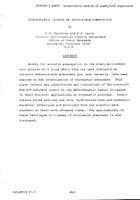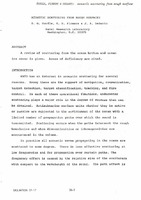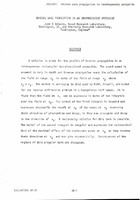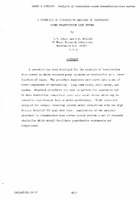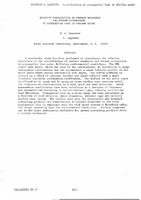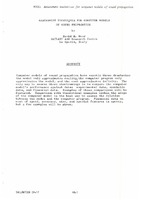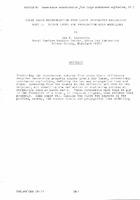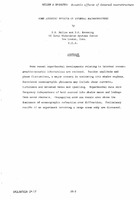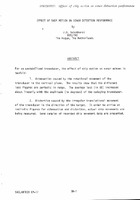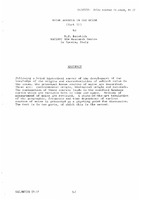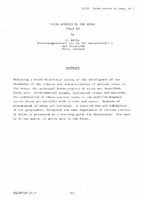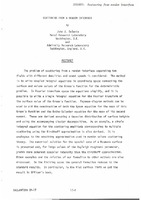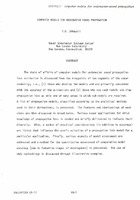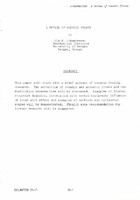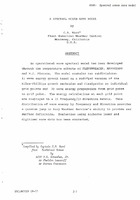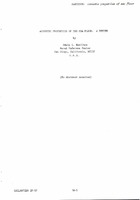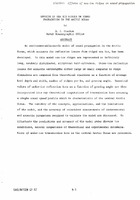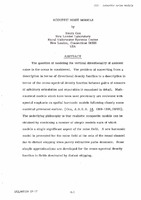Browsing Reprints by Issue Date
Now showing items 81-100 of 548
-
Deterministic methods of sound field computation
(NATO. SACLANTCEN, 1975/10)Models for acoustic propagation in the ocean environment have matured to a level where they are used routinely to estimate deterministic phenomena and, most recently, have been applied to the investigation of stochastic ... -
Acoustic scattering from rough surfaces
(NATO. SACLANTCEN, 1975/10)A review of scattering from the ocean bottom and ocean ice cover is given. Areas of deficiency are cited. -
Inverse wave propagation in an inhomogeneous waveguide
(NATO. SACLANTCEN, 1975/10)A solution is given for the problem of inverse propagation in an inhomogeneous rectangular two-dimensional waveguide. The sound speed is assumed to vary in depth and inverse propagation means the calculation of the field ... -
A technique of comparative analysis of underwater sound transmission loss curves
(NATO. SACLANTCEN, 1975/10)A procedure has been developed for the analysis of transmission loss curves in which received power is known or expressible as a linear function of range. The procedure separates each curve into a sum of three components ... -
Relative contribution of surface roughness and bottom attenuation to propagation loss in shallow water
(NATO. SACLANTCEN, 1975/10)A simulation study has been performed to investigate the relative importance of the contributions of surface roughness and bottom attenuation to propagation loss under differing environmental conditionso The NRL normal ... -
Assessment techniques for computer models of sound propagation
(NATO. SACLANTCEN, 1975/10)Computer models of sound propagation have exactly three drawbacks: the model only approximates reality,the computer program only approximates the model, and the cost approximates infinity. The only way to assess these ... -
Ocean-basin reverberation from large underwater explosions: part 1: source-level and propagation-loss modelling
(NATO. SACLANTCEN, 1975/10)Predicting the reverberant returns from ocean basin reflectors requires describing acoustic source levels for large, conventional underwater explosions, defining the two way propagation loss and signal spreading from the ... -
Some acoustic effects of internal macrostructure
(NATO. SACLANTCEN, 1975/10)Some recent experimental developments relating to internal oceanographic- acoustic interactions are reviewed. Besides amplitude and phase fluctuations, a major concern is scattering into shadow regions. Associated oceanographic ... -
Effect of ship motion on sonar detection performance
(NATO. SACLANTCEN, 1975/10)For an unstabilized transducer, the effect of ship motion on sonar echoes is twofold: 1. Attenuation caused by the rotational movement of the transducer in the vertical plane. The results show that the different loss figures ... -
Noise sources in the ocean - part 2
(NATO. SACLANTCEN, 1975/10)Following a brief historical survey of the development of our knowledge of the origins and characteristics of ambient noise in the ocean, the principal known sources of noise are described. These are: environmental origin, ... -
Acoustic scintillations of acoustic waves
(NATO. SACLANTCEN, 1975/10) -
Noise sources in the ocean - part 1
(NATO. SACLANTCEN, 1975/10)Following a brief historical survey of the development of our knowledge of the origins and characteristics of ambient noise in the ocean, the principal known sources of noise are described. These are: environmental origin, ... -
Scattering from a random interface
(NATO. SACLANTCEN, 1975/10)The problem of scattering from a random interface separating two fluids with different densities and sound speeds is considered. The method is to write coupled integral equations in coordinate space connecting the surface ... -
Computer models for underwater sound propagation
(NATO. SACLANTCEN, 1975/10)The state of affairs of computer models for underwater sound propagation loss estimation is discussed from the viewpoints of two segments of the sonar community; i.e., (1) those who develop the models and are primarily ... -
Intensity and phase fluctuations in low-frequency acoustic transmission through internal waves
(NATO. SACLANTCEN, 1975/10) -
A review of oceanic fronts
(NATO. SACLANTCEN, 1975/10)This paper will start with a brief account of oceanic frontal research. The definition of oceanic and acoustic fronts and the distinction between them will be discussed. Examples of frontal structure dynamics, correlation ... -
A spectral ocean wave model
(NATO. SACLANTCEN, 1975/10)An operational wave spectral model has been developed through the cooperative efforts of FLENUMWEACEN, NAVOCEANO and W.J. Pierson. The model contains two subdivisions: 1) wave energy growth based on a modified version of ... -
Acoustic properties of the sea floor: a review
(NATO. SACLANTCEN, 1975/10) -
Effects of sea-ice ridges on sound propagation in the Arctic Ocean
(NATO. SACLANTCEN, 1975/10)An environmental/acoustic model of sound propagation in the Arctic Ocean, which accounts for reflection losses from ridged sea ice, has been developed. In this model sea-ice ridges are represented as infinitely long, ... -
Acoustic noise models
(NATO. SACLANTCEN, 1975/10)The question of modeling the vertical directionality of ambient noise in the ocean is considered. The problem of converting from a description in terms of directional density function to a description in terms of the ...
